

Clack, clack, clack: Four gamer keyboards compared
Razer, Corsair, Asus ROG and Roccat - these names make gamers' hearts beat faster. All suppliers have recently released new high-end gamer keyboards, some with new technology. I took a closer look at four of them.
Clicky, tactile or rather linear? In most places in the world, I would probably get a quizzical look at this question. Not so on our editorial team. Here, a veritable war of opinions is about to break out. Keyboards - or to be more precise: their switches - move people's minds. It's great that I have four models with different switch technologies to test. I'm particularly looking forward to the model with the Clicky switches, not just because I love them, but because I can really get on the nerves of my colleague Martin Jud.
The four keyboards are: "Huntsman" from Razer, "Strix Flare" from Asus ROG, "Vulcan 120 Aimo" from Roccat and last but not least "K70 RGB MK.2 Low Profile" from Corsair.
To each his own style
Of course, you can activate colourful RGB flashing on all keyboards. What else characterises the design of the individual keyboards?
K70 RGB MK.2 Low Profile
The K70 - I'll just call it that now because of the awkward name - is flat. Not in terms of quality, I'll come to that later, but in terms of design. With a height of 29 mm, it can be stowed away after use even in tight spaces. The top plate of the K70 is made of aircraft aluminium and it weighs a total of 1080 grams at 43.8 × 16.8 × 2.9 cm. As is typical for Corsair, the keys are labelled with wide, futuristic-looking letters and numbers.
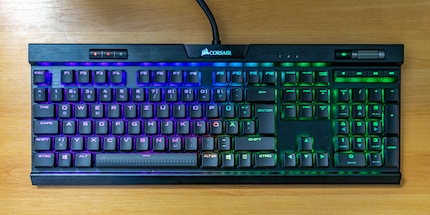
In addition to the usual QWERTY keys with number pad, the K70 has a wheel at the top right and five keys for volume and multimedia control. There is also a button for switching profiles, one for adjusting the brightness of the backlight and the Windows lock button at the top left. Corsair includes a plastic palm rest that you attach to the keyboard with barbs.
The keys are framed by a raised section at the top and bottom. Only the volume control and the three keys at the top left are located on the upper bump. Due to the flat design of the keyboard and switches, the keyboard looks a little compressed between the bumps - somehow reminds me of the Swiss midlands, the only thing missing is the fog. A screw can be seen next to the Esc key. Surprising, as Corsair skilfully conceals the other screws.
The K70 uses two USB ports. In return, you get a USB-A passthrough port on the back of the keyboard. This gives you back the lost USB 2.0 slot for your mouse.
Vulcan 120 Aimo
The Vulcan is the complete opposite of the K70. Instead of being flat, the keys protrude from the aluminium cover plate like volcanoes. The frame is less thick than Corsair's and the keyboard is 32 mm high overall. Measuring 46.2 × 16 × 3.2 cm and weighing 1150 grams, the Vulcan is slightly larger and heavier than the K70. The keys are also boldly labelled, but slightly smaller than Corsair's.
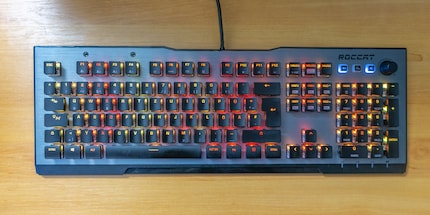
In addition to the usual QWERTY keys, there is a volume control and three more in the top right-hand corner. You can mute with one. Use the other two to select what the volume control should adjust. In addition to the volume, you can also set the backlight level.
The grey frame is surrounded by a black edge that is slightly wider at the bottom. You can attach the magnetic wrist rest to this. The black keys stand out strongly against the grey surface. The effect is further emphasised by the RGB lighting - or light play art, as Roccat calls it. With Roccat, you can see two screws. But that's not a bad thing, because Roccat doesn't want to hide its case, you can also see into the spaces between the keys.
The Vulcan 120 Aimo comes with a USB cable. But you don't get USB passthrough either.
Strix Flare
In addition to the key illumination, the keyboard from Asus also comes with underbody lighting and an illuminated ROG logo on a transparent surface. You can also replace the logo with one of your choice. It is the only keyboard made entirely of plastic and still weighs around 1256 grams. Amazing, because at 45.4 × 15.5 × 3.1 cm, it is smaller than the Vulcan. Asus also bangs the letters and numbers onto the keys in bold, futuristic-looking lettering.
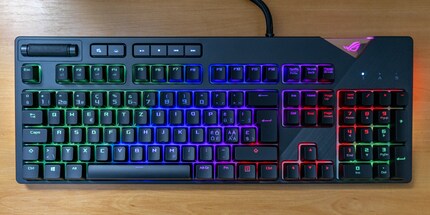
On the Strix Flare, the volume control and the special buttons are located from the top left to the centre. In addition to the volume control, there are four playback buttons, the Windows lock button and a button for adjusting the backlight. The Strix Flare also has a palm rest. You attach it under the keyboard.
The Asus keyboard is divided into two parts by a diagonal line. The left part is black and the right is anthracite. This is where the numeric keypad and arrow keys are located. Otherwise, the keyboard is kept simple by Asus standards - at least until you activate the backlight. Then the typical Asus flashing appears.
Like the K70, the Strix Flare requires two USB ports. Here, too, you can get one port back with USB passthrough on the back of the keyboard.
Razer Huntsman
The Huntsman looks the sleekest of all keyboards. At 44.5 × 14 × 3.5 cm, it is the tallest keyboard, but otherwise the smallest. Apart from the RGB lighting, there is nothing to suggest it is a gaming keyboard. You almost have to look for the Razer logo on the black cover plate. This may be because I have the standard model of the Huntsman. With the Elite version, you also get media keys and a volume control, which makes it look more like a gamer peripheral.
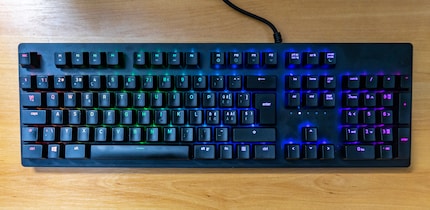
Razer also plays it simple with the key labelling, which reminds me of a slightly more playful Logitech office keyboard. You don't get a palm rest with the standard version of the Huntsman, it's only available with the Elite version.
Other than that, there's nothing major to say about the design of the Huntsman. In contrast to the other keyboards, it only has a very narrow edge. Visually, I like it best by far because it's so simple, but that's a matter of taste.
The Huntsman comes with a cable, but you have to do without USB passthrough.
Linear, tactile or rather clicky?
This is a controversial question. Some of my editorial colleagues harbour almost religious feelings towards switches. Colleagues Dominik Bärlocher and Simon Balissat would prefer clicky, clicky or tactile.like clicky, Philipp Rüegg and Raphael Knecht are into tactile keyboards. And you won't find anyone who likes linear switches. I like retro, much to the chagrin of Martin Jud. The more switches sound like an old typewriter, the better. What could be better than the sound of an old typewriter? As a Clicky fan, I therefore have to write about the switches on the Razer Huntsman first.
Clicky for maximum feedback: Opto-mechanical switch
The opto-mechanical switches specially developed by Razer have an integrated light sensor. When you press the button, a receiver picks up the light signal, triggers it and is immediately reset. This should enable faster triggering than with other switches. The service life should also be longer with up to 100 million clicks. Triggering is very easy. Only 45 grams of triggering force are required. It is 1.5 millimetres to the switching point and the button travel is 3.5 millimetres.
Tactile for a little less feedback: Titan Switch
The Titan switches are an in-house development from Roccat. Roccat cites the improved debounce mechanism and the reinforced switch frame as the most important new features. The debounce mechanism includes a more solid suspension and more conductive materials. As a result of this and adjustments to the firmware, inputs should be registered up to 20 per cent faster. As with the Huntsman, only 45 grams of trigger force is required. The trigger point on the Vulcan is 1.8 millimetres and the key travel is 3.6 millimetres.
Without feedback: Cherry MX Silver and Cherry MX Low Profile Speed
Asus is the only one of the four manufacturers not to rely on any new developments. The Strix Flare is equipped with tried-and-tested Cherry MX Silver switches. The switching point is slightly longer and is 1.2 millimetres. The key travel is 3.4 mm. With 45 grams of trigger force, the same amount of pressure is required as for the Huntsman and Vulcan.
The Cherry MX Low Profile Speed Switches were developed exclusively for Corsair. They enable a lower key height. Otherwise, the linear switches are similar to the Cherry MX Red. Like the others, the trigger force is 45 grams. The trigger point is 1 millimetre and the key travel is 3.2 millimetres.
What the software can do
Of course, each manufacturer supplies its own software for controlling the backlighting. All manufacturers have created a veritable RGB universe. That's why I expect it to be easy to use. As I realise during setup, I find all the software confusing and bulky. I have to make certain settings in submenus that are difficult to find. And depending on the software, I have to select the settings separately. I would like to see a little more user-friendliness from the manufacturers here.
Asus Aura or Armoury II?
I'm used to the Aura software from Asus. Unfortunately, I can only set the keyboard backlight with this. I need the Armoury II software for other options. However, for this to run, it asks me to deactivate Aura first. No sooner said than done, but unfortunately I still can't get into the software. Only after I have uninstalled Aura does Armoury II let me make changes.
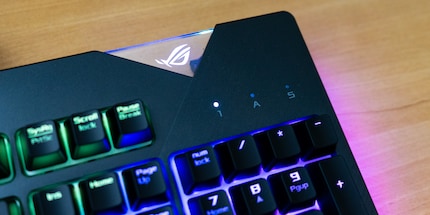
In the software, I can then create various profiles for the Strix Flare. This includes not only the lighting, but also the key assignment. You can also record macros and hardware statistics. You can also save up to six profiles on the keyboard itself. The settings worked without any problems with Armoury II.
Corsair iCue
What doesn't work straight away with Asus works better with Corsair. In iCue, I can select the keyboard and make various settings for the K70. I can also configure the backlighting and key assignment and create macros. You can store up to three profiles on the keyboard's internal memory.
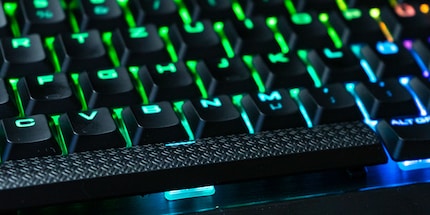
Razer Synapse
In Razer Synapse, you can make similar settings for the Huntsman as in the other two programmes. In addition to backlighting, you can configure the key assignment and save up to five profiles on the keyboard itself.

Roccat Swarm
Roccat also offers the same setting options with its software. You can save up to four profiles on the keyboard itself. A nice, albeit somewhat useless gimmick: as the Roccat Vulcan 120 Aimo is a tactile keyboard and does not make a clicking sound, you can add a trigger sound on the software side.
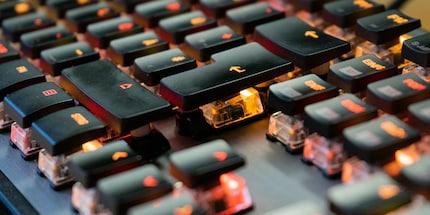
What are these things good for in practice?
First things first: I enjoyed gaming with all the keyboards. Each of the keyboards responds precisely and quickly. I can recommend all of them for gaming, they are all very good keyboards. Ultimately, you need to know which keyboard suits you best in terms of design, switches and usage.
You may have already noticed that I like the Huntsman. I love the click when typing. The feedback is accurate and reliable. I didn't notice any ghosting while playing. The keys offer good grip so that you don't slip even in heated battles. The trigger point of 1.5 millimetres is the perfect balance between gaming and typing for me. However, the Huntsman is very loud. You need understanding people who can deal with the typing noise. It is rather unsuitable for an open-plan office.

The Vulcan also suited me very well. It offers very good feedback, even without the nice clicking noise. It's a lot quieter than the Huntsman. If you look at the design of the switches, you might be worried that they are unstable. But this is not the case. You can press the switches down in a controlled manner and they release precisely. At 1.8 millimetres, the trigger point is slightly larger than on the Huntsman. Compared to the Cherry MX Blue or Red, however, it is still smaller. I also did not notice any ghosting effects.

The K70 differs from the Huntsman and Vulcan with its linear Cherry MX Low Profile Speed Switches. Personally, I'm not a fan of linear switches. But I still enjoyed gaming with the K70. Thanks to the low trigger point of 1 millimetre, it triggers extremely quickly and precisely. The K70 is certainly ideal for competitive games. It is also very quiet due to the lack of feedback. Despite the low trigger point and trigger force, I have rarely triggered it incorrectly. With a little practice, it would probably never happen to me again. Ghosting was also not a topic with the K70.

With the Strix Flare and the installed Cherry MX Silver, Asus relies on proven technology. Like the K70, the Strix Flare is suitable for competitive games due to its low trigger point and trigger force. The switches respond quickly, precisely and reliably. Compared to the Huntsman and Vulcan, the feedback isn't as concise. Although they are linear switches, I can feel the trigger point. As with the other keyboards, I couldn't detect any ghosting effects. Incidentally, the Strix Flare is also available with Cherry MX Brown switches. With its relatively long key travel and high actuation force, this version is more suitable for quieter games.

Conclusion
All keyboards are solidly built and offer a great gaming experience. In terms of the materials used, the Strix Flare is somewhat disappointing. The keyboard doesn't feel quite as high-quality as the other keyboards due to the lack of an aluminium top plate.
In terms of price, the keyboards are up to 65 francs apart. The Corsair keyboard will set you back the most at just under 219 francs. Asus is the cheapest at 154 francs, followed by Razer at around 170 francs and the Roccat is only slightly more expensive at 180 francs. Is the Corsair worth the money? In terms of quality, definitely, and if you want linear switches with a 1 millimetre trigger point, there's no way around the K70. Corsair has probably paid for the exclusive rights to the switches and is passing this on to the customer.
If you can do without linear switches or don't like them anyway, you won't have to dig as deep into your pockets with Roccat and Razer. The Huntsman is for clicky enthusiasts who still want a great gaming experience. The Roccat not only looks damn cool - and I say that as an RGB hater - but it's also a joy to type on.
If you want something tried and tested and already have a lot of hardware and peripherals from Asus anyway, the Strix Flare will probably suit your taste. Unfortunately, even after several attempts, I was unable to run the Aura software at the same time as the Armoury II software for key mapping.
The Razer Huntsman convinced me. In contrast to the other keyboards, you don't get quite as fancy RGB lighting and you also have to do without special keys - you'd have to go for the Elite version. However, I like the clean look and the typing feel and noise are simply brilliant. It's a shame that my office colleagues don't feel the same way about the noise emission, otherwise I would buy the Huntsman for the office.
Here are the keyboards in the shop's comparison tool.
From big data to big brother, Cyborgs to Sci-Fi. All aspects of technology and society fascinate me.


